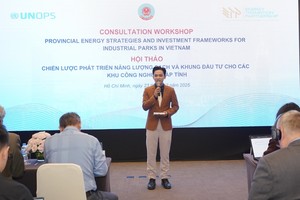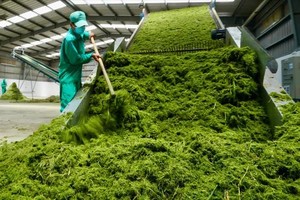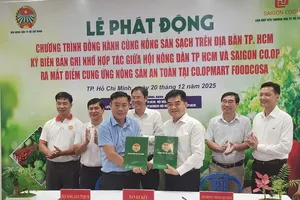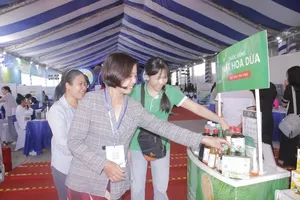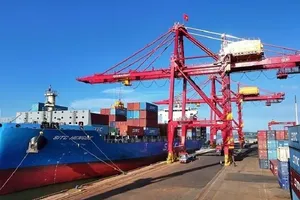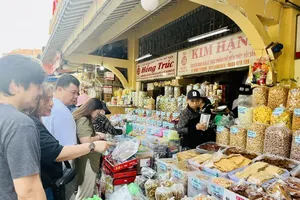Vietnam’s cotton-growing industry has been shrinking for years, while the booming textile and garment sector has been forced to rely on imported fibers to maintain productivity.
Around eight years ago, cotton was cultivated on approximately 30,000 hectares of land in the country with an average productivity of 1.5 tons of cotton per hectare. This met just 10 percent of domestic garment and textile industry demand. The cotton sector earned VND405 billion (US$23 million) each year.
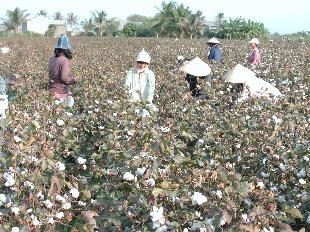
Farmers in Ayun Pa District, in the Central Highlands province of Gia Lai, plant nearly 1,000 hectares of cotton with an average yield of three tons per ha. (File photo)
To help meet the needs of the industry, the Ministry of Agriculture and Rural Development targeted to increase the number of hectares on which cotton was grown to an ambitious 230,000 hectares by 2010.
But by 2007-2008, land for cotton growing had in fact decreased by 5,000-10,000 hectares. This now met just 3-5 percent of the local textile and garment industry’s needs.
With the decline in production, the Government approved a new plan to develop cotton cultivation until 2015 with a view to 2020. The plan targeted to increase cotton growing to 30,000- 40,000 hectares, with a total output of 20,000 tons in 2010.
But as of 2009, the total area of cotton cultivation was just 8,000 hectares nationwide, far short of the goal.
Farmers discouraged by low cotton profits
In 2007-2008, cotton was cultivated on 6,000 hectares nationwide, with output of just 2,600 tons of fiber.
The Central Highland province of Gia Lai was one of the largest areas to produce cotton with 5,000-6,000 hectares of growing area. Today, however, cotton is grown on less than 1,000 hectares of land here.
Agricultural experts said the country’s cotton prices and productivity could not compete with imported cotton because farmers from other countries receive government subsidies.
In addition, local farmers are deterred from growing cotton because more money can be made from other crops such as coffee and rubber.
Domestic farmers can earn a profit of VND3 million ($179) from each hectare of cotton they grow, but they can earn up to VND10 million ($598) per hectare from other crops such as maize.
Before Vietnam joined the World Trade Organization (WTO), the government applied import quotas on cotton, but the cheap price of American and African cotton did little to discourage trade.
After Vietnam became a member of the WTO, it had to reduce import taxes on cotton, so in turn, cotton-purchasing companies could not increase cotton prices for farmers.
In 2008, the price of cotton even increased from VND7,000 per kilogram to VND9,000, but this was still not enough to help revive the industry.
Productivity plans revamped
Earlier this month, Prime Minister Nguyen Tan Dung approved a new plan to develop cotton cultivation until 2015.
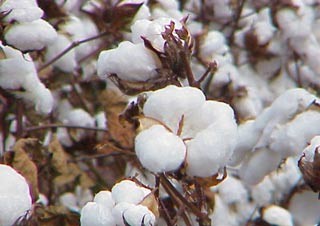
As of now, cotton-growing sector only meets 3-5 percent of the local textile and garment industry’s needs. (Filed photo)
The plan targets to produce cotton on around 30,000 hectares of land, with average productivity of 1.5-2 tons per hectare by 2015. By 2020, it is hoped farmers will cultivate the crop on 76,000 hectares, with a total output of 2-2.5 tons per hectare.
To reduce cotton imports and ensure the local textile and garment sector is provided with enough of the fiber, the Government also plans to focus on intensive farming to raise cotton output and quality. It strives to develop large cotton plantations in many Central Highlands provinces, along the south-central coast, and northern mountainous areas.
Moreover, a fund to help stabilize cotton prices will be set up to ensure benefits to growers while low-interest loans will be made available to farmers.
The Government will also encourage cotton processors to support cotton growers in mechanizing their cultivation processes from preparing land to harvesting and preserving the fiber.
Experts say that local authorities and related industry sectors need to coordinate with each other to overcome obstacles to cotton production and breathe new life into the industry.


